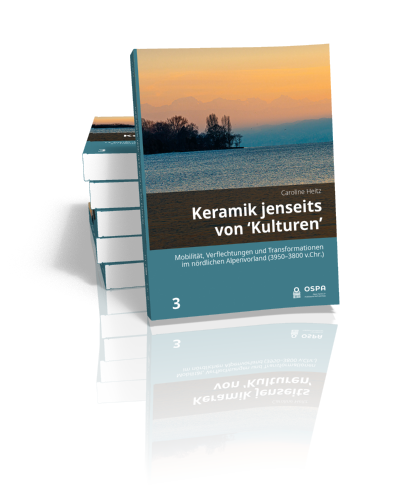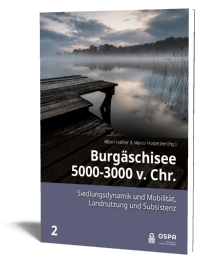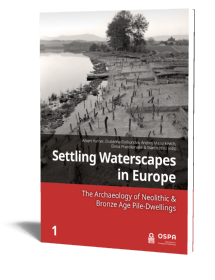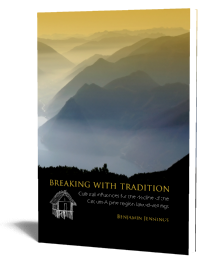Keramik jenseits von 'Kulturen'
Mobilität, Verflechtungen und Transformationen im nördlichen Alpenvorland (3950–3800 v.Chr.)
Caroline Heitz | 2023

Keramik jenseits von 'Kulturen'
Mobilität, Verflechtungen und Transformationen im nördlichen Alpenvorland (3950–3800 v.Chr.)
Caroline Heitz | 2023
Paperback ISBN: 9789464280456 | Hardback ISBN: 9789464280463 | Imprint: Sidestone Press Dissertations | Format: 210x280mm | 504 pp. | Open Series in Prehistoric Archaeology 3 | Series: OSPA: Open Series in Prehistoric Archaeology | Language: German | 56 illus. (bw) | 156 illus. (fc) | Keywords: ceramics; mobility; transformation; habitus; praxeology; reflexive archaeology; classification; mixed method research; prehistoric lakeside settlements; neolithic; UNESCO worldheritage | download cover | DOI: 10.5281/zenodo.7408967 | CC-license: CC BY-NC 4.0
Read online or downloaded 721 times
-
Digital & Online access
This is a full Open Access publication, click below to buy in print, browse, or download for free.
-
Buy via Sidestone (EU & UK)
-
Buy via our Distributors (WORLD)
For non-EU or UK destinations you can buy our books via our international distributors. Although prices may vary this will ensure speedy delivery and reduction in shipping costs or import tax. But you can also order with us directly via the module above.
UK international distributor
USA international distributor
-
Bookinfo
Paperback ISBN: 9789464280456 | Hardback ISBN: 9789464280463 | Imprint: Sidestone Press Dissertations | Format: 210x280mm | 504 pp. | Open Series in Prehistoric Archaeology 3 | Series: OSPA: Open Series in Prehistoric Archaeology | Language: German | 56 illus. (bw) | 156 illus. (fc) | Keywords: ceramics; mobility; transformation; habitus; praxeology; reflexive archaeology; classification; mixed method research; prehistoric lakeside settlements; neolithic; UNESCO worldheritage | download cover | DOI: 10.5281/zenodo.7408967 | CC-license: CC BY-NC 4.0
Read online or downloaded 721 times

We will plant a tree for each order containing a paperback or hardback book via OneTreePlanted.org.
Mobilität ist für Formen des sozialen Zusammenlebens grundlegend. Doch welche Rolle spielte räumliche Mobilität in der Vergangenheit? Aus prähistorischen Zeitabschnitten wie etwa dem Neolithikum ist dazu noch immer wenig bekannt. Das gilt auch für die Siedlungsräume des nördlichen Alpenvorlandes. Deren Feuchtbodensiedlungen mit den hervorragend erhaltenen Resten in Seen und Mooren gehören seit 2011 zum UNESCO Welterbe und bieten eine einzigartige Forschungsgrundlage. Die dendrochronologisch datierten Siedlungen eröffnen die seltene Möglichkeit, kulturelle, soziale und ökonomische Transformationen zeitlich und räumlich hochauflösend zu untersuchen. Das gelingt im vorliegenden Band anhand der Keramik aus zeitgleich datierten Siedlungen am Zürichsee und Bodensee aus der Zeit zwischen 3950 und 3800 v.Chr.
Prozessphilosophische Überlegungen zum Entstehen und dem Wandel von ‘Dingen’ werden mit relationalen sozialtheoretischen Konzepten wie etwa dem Habitus-Theorem zu einem praxeologischen Ansatz verbunden. Dieser dient als epistemologische Grundlage einer neu ausgearbeiteten ‘Mixed Methods Research’-Methodologie, die ein tieferes Verständnis von Mobilität, Beziehungsgeflechten, sozialen Konfigurationen und Transformationen ermöglicht: Mit qualitativen Klassifikationsmethoden können soziale Praktiken der Keramikherstellung aus der Handlungsperspektive nachvollzogen werden und mit quantitativen Klassifikationsmethoden überregionale Muster der Keramikkonsumption. Anhand solcher materieller Verflechtungen werden Muster räumlicher Mobilität sowie die weitreichenden Beziehungen der jeweiligen Siedlungsgemeinschaften erkennbar. Im Rhythmus einzelner Dekaden lassen sich mobilitätsbezogene Aneignungsphänomene und Transformationen in den Keramikpraktiken nachvollziehen. Darüber hinaus führt die Kombination einer subjektivistischen mit einer ‘objektivierten’ Haltung im Forschungsprozess auf Basis von Pierre Bourdieus Epistemologie, der Praxeologie, zu einem erkenntnistheoretischen, metamodernen ‘dritten Weg’, der zwischen dem Realismus der Moderne (Prozessuale Archäologie) und dem Konstruktivismus der Postmoderne (Postprozessuale Archäologie) vermittelt. Dadurch werden kulturhistorische Gesellschaftsmodelle dekonstruiert, welche ‘Kulturen’ als vermeintlich statische, homogene, räumlich klar abgrenzbare Entitäten konzeptualisierten. Stattdessen verweist die Keramik auf translokale soziale Konfigurationen, durch welche die Siedlungen während des 4. Jahrtausends v.Chr. im nördlichen Alpenvorland miteinander verbunden waren.
English abstract
Mobility is fundamental to forms of social configurations. But what role did spatial mobility play in the past? Regarding prehistoric periods, such as the Neolithic, we still do know little about this. That also applies to the settlement areas of the northern Alpine Foreland. The wetland settlements there were labelled UNESCO World Heritage in 2011. With their excellently preserved remains in lakes and bogs they provide a unique research basis. The dendrochronologically dated settlements open a rare possibility to approach cultural, social, and economic processes based on a high temporal and spatial resolution. In the present volume, this is achieved based on pottery from contemporaneously dated settlements on Lake Zurich and Lake Constance from the period between 3950 and 3800 BC.
Process philosophical considerations on the (trans)formation of ‘things’ are combined with relational social theoretical concepts such as the habitus theorem to form a praxeological approach. The latter serves as the epistemological basis of the newly elaborated mixed method research methodology, which allows for a deeper understanding of mobility, social relations and configurations as well as transformations. Qualitative methods (classification of vessel designs) is utilised to understand pottery production practices from the perspective of the makers and quantitative methods (cluster analysis of vessel features) can be used to analyse transregional structures of ceramic consumption. Accordingly, patterns of spatial mobility and far-reaching relationships of settlement communities become apparent based on such material entanglements. Mobility-related appropriation phenomena and change in pottery practices can be approached in the rhythm of individual decades. Furthermore, the combination of a subjectivist with an ‘objectified’ stance during the research process based on Pierre Bourdieu’s epistemology, the praxeology, leads to an epistemological, metamodern ‘third way’ that mediates between the realism of modernity (processual archaeology) and the constructivism of postmodernity (post-processual archaeology). Finally, the research results deconstruct the common social models following the cultural-historical paradigm, which conceptualized ‘cultures’ as supposedly static, homogeneous, spatially distinct entities. Instead, the pottery points to translocal social configurations that related settlements in the northern Alpine Foreland with each other in the 4th millennium BC.
1. Einleitung
2. Keramische ‘Fremdformen’ in ‘neolithischen Kulturen’
2.1 Das kulturgeschichtliche Paradigma in der Ethnologie und Archäologie
2.2 ‘Kulturen’ in der Schweizer Neolithikum-Forschung
3. Neue Paradigmen – Von der Post- zur Metamoderne
3.1 In drei ‘Turns’ von ‘Kulturen’ zu ‘Verflechtungen’
3.2 Neuer Materialismus, neuer Realismus?
4. Perspektiven und Theorien
4.1 Ding-Ontologie, Ding-Ontogenese
4.2 Ding-Epistemologien
4.3 Ding-Theorien – Keramik und soziale Praxis
4.4 Mobilitäts-Theorien – Menschen und Dinge, Bewegung und Begegnung
4.5 Keramik und Mobilität – Ein Untersuchungsmodell
5. Mixed Methods – Qualitative und quantitative Methoden
5.1 Klassifikationsansätze
5.2 Vom ‘Material’ zur Datenbasis
5.3. Methoden zur Klassifikation von Stilmerkmalen
6. Material, Raum und Zeit
6.1 Räume – Nördliches Alpenvorland, angrenzende Regionen
6.2 Key Sites – Zwei Priorisierungsstufen, zwei Perspektiven
6.3 Supralokale Perspektiven – Siedlungsräume und Datierungen im Überblick
6.4 C14-Kalibrationsmodelle
6.5 Lokale Perspektiven – Siedlungen im Boden- und Zürichseegebiet
7. Gefässdesigns – Perspektive der Produktion
7.1 Qualitative Klassifikation – Siedlungsperspektiven
7.2 Stilistische Verflechtungen
8. Gefässpotenziale – Perspektive der Konsumption
8.1 Quantitative unüberwachte Klassifikation – überregionale Perspektiven
8.2 Ähnlichkeitsbezüge bei Gefässpotenzialen
9. Synthese
9.1 Mobilität, Verflechtungen und Transformationen anhand von Keramik
9.2 Alternativmodelle zu ‘neolithischen Kulturen’– Translokale soziale Konfigurationen
9.3 Fazit und Ausblick – Mixed Methods und die metamoderne Archäologie
10. Elektronische Anhänge und Datensätze
11. Literaturverzeichnis
12. Abbildungsverzeichnis

Dr. Caroline Heitz
Caroline Heitz is a Senior Researcher and SNSF-Ambizione Grantee at the Institute of Archaeological Sciences and the Oeschger Center for Climate Change Research at the University of Bern. In her award-winning doctoral thesis, she combined research on mobility, entanglement, appropriation, and transformation in relation to Neolithic pottery from the UNESCO-World Heritage wetland sites around the Alps. She was also awarded a Postdoc-Mobility Grant from the Swiss National Science Foundation and became a fellow at the Universities of Oxford and Kiel in 2021–2022. She is currently conducting research on social archaeology as well as climate change resilience and vulnerabilities of prehistoric waterfront communities.
Abstract:
Mobilität ist für Formen des sozialen Zusammenlebens grundlegend. Doch welche Rolle spielte räumliche Mobilität in der Vergangenheit? Aus prähistorischen Zeitabschnitten wie etwa dem Neolithikum ist dazu noch immer wenig bekannt. Das gilt auch für die Siedlungsräume des nördlichen Alpenvorlandes. Deren Feuchtbodensiedlungen mit den hervorragend erhaltenen Resten in Seen und Mooren gehören seit 2011 zum UNESCO Welterbe und bieten eine einzigartige Forschungsgrundlage. Die dendrochronologisch datierten Siedlungen eröffnen die seltene Möglichkeit, kulturelle, soziale und ökonomische Transformationen zeitlich und räumlich hochauflösend zu untersuchen. Das gelingt im vorliegenden Band anhand der Keramik aus zeitgleich datierten Siedlungen am Zürichsee und Bodensee aus der Zeit zwischen 3950 und 3800 v.Chr.
Prozessphilosophische Überlegungen zum Entstehen und dem Wandel von ‘Dingen’ werden mit relationalen sozialtheoretischen Konzepten wie etwa dem Habitus-Theorem zu einem praxeologischen Ansatz verbunden. Dieser dient als epistemologische Grundlage einer neu ausgearbeiteten ‘Mixed Methods Research’-Methodologie, die ein tieferes Verständnis von Mobilität, Beziehungsgeflechten, sozialen Konfigurationen und Transformationen ermöglicht: Mit qualitativen Klassifikationsmethoden können soziale Praktiken der Keramikherstellung aus der Handlungsperspektive nachvollzogen werden und mit quantitativen Klassifikationsmethoden überregionale Muster der Keramikkonsumption. Anhand solcher materieller Verflechtungen werden Muster räumlicher Mobilität sowie die weitreichenden Beziehungen der jeweiligen Siedlungsgemeinschaften erkennbar. Im Rhythmus einzelner Dekaden lassen sich mobilitätsbezogene Aneignungsphänomene und Transformationen in den Keramikpraktiken nachvollziehen. Darüber hinaus führt die Kombination einer subjektivistischen mit einer ‘objektivierten’ Haltung im Forschungsprozess auf Basis von Pierre Bourdieus Epistemologie, der Praxeologie, zu einem erkenntnistheoretischen, metamodernen ‘dritten Weg’, der zwischen dem Realismus der Moderne (Prozessuale Archäologie) und dem Konstruktivismus der Postmoderne (Postprozessuale Archäologie) vermittelt. Dadurch werden kulturhistorische Gesellschaftsmodelle dekonstruiert, welche ‘Kulturen’ als vermeintlich statische, homogene, räumlich klar abgrenzbare Entitäten konzeptualisierten. Stattdessen verweist die Keramik auf translokale soziale Konfigurationen, durch welche die Siedlungen während des 4. Jahrtausends v.Chr. im nördlichen Alpenvorland miteinander verbunden waren.
English abstract
Mobility is fundamental to forms of social configurations. But what role did spatial mobility play in the past? Regarding prehistoric periods, such as the Neolithic, we still do know little about this. That also applies to the settlement areas of the northern Alpine Foreland. The wetland settlements there were labelled UNESCO World Heritage in 2011. With their excellently preserved remains in lakes and bogs they provide a unique research basis. The dendrochronologically dated settlements open a rare possibility to approach cultural, social, and economic processes based on a high temporal and spatial resolution. In the present volume, this is achieved based on pottery from contemporaneously dated settlements on Lake Zurich and Lake Constance from the period between 3950 and 3800 BC.
Process philosophical considerations on the (trans)formation of ‘things’ are combined with relational social theoretical concepts such as the habitus theorem to form a praxeological approach. The latter serves as the epistemological basis of the newly elaborated mixed method research methodology, which allows for a deeper understanding of mobility, social relations and configurations as well as transformations. Qualitative methods (classification of vessel designs) is utilised to understand pottery production practices from the perspective of the makers and quantitative methods (cluster analysis of vessel features) can be used to analyse transregional structures of ceramic consumption. Accordingly, patterns of spatial mobility and far-reaching relationships of settlement communities become apparent based on such material entanglements. Mobility-related appropriation phenomena and change in pottery practices can be approached in the rhythm of individual decades. Furthermore, the combination of a subjectivist with an ‘objectified’ stance during the research process based on Pierre Bourdieu’s epistemology, the praxeology, leads to an epistemological, metamodern ‘third way’ that mediates between the realism of modernity (processual archaeology) and the constructivism of postmodernity (post-processual archaeology). Finally, the research results deconstruct the common social models following the cultural-historical paradigm, which conceptualized ‘cultures’ as supposedly static, homogeneous, spatially distinct entities. Instead, the pottery points to translocal social configurations that related settlements in the northern Alpine Foreland with each other in the 4th millennium BC.
Contents
1. Einleitung
2. Keramische ‘Fremdformen’ in ‘neolithischen Kulturen’
2.1 Das kulturgeschichtliche Paradigma in der Ethnologie und Archäologie
2.2 ‘Kulturen’ in der Schweizer Neolithikum-Forschung
3. Neue Paradigmen – Von der Post- zur Metamoderne
3.1 In drei ‘Turns’ von ‘Kulturen’ zu ‘Verflechtungen’
3.2 Neuer Materialismus, neuer Realismus?
4. Perspektiven und Theorien
4.1 Ding-Ontologie, Ding-Ontogenese
4.2 Ding-Epistemologien
4.3 Ding-Theorien – Keramik und soziale Praxis
4.4 Mobilitäts-Theorien – Menschen und Dinge, Bewegung und Begegnung
4.5 Keramik und Mobilität – Ein Untersuchungsmodell
5. Mixed Methods – Qualitative und quantitative Methoden
5.1 Klassifikationsansätze
5.2 Vom ‘Material’ zur Datenbasis
5.3. Methoden zur Klassifikation von Stilmerkmalen
6. Material, Raum und Zeit
6.1 Räume – Nördliches Alpenvorland, angrenzende Regionen
6.2 Key Sites – Zwei Priorisierungsstufen, zwei Perspektiven
6.3 Supralokale Perspektiven – Siedlungsräume und Datierungen im Überblick
6.4 C14-Kalibrationsmodelle
6.5 Lokale Perspektiven – Siedlungen im Boden- und Zürichseegebiet
7. Gefässdesigns – Perspektive der Produktion
7.1 Qualitative Klassifikation – Siedlungsperspektiven
7.2 Stilistische Verflechtungen
8. Gefässpotenziale – Perspektive der Konsumption
8.1 Quantitative unüberwachte Klassifikation – überregionale Perspektiven
8.2 Ähnlichkeitsbezüge bei Gefässpotenzialen
9. Synthese
9.1 Mobilität, Verflechtungen und Transformationen anhand von Keramik
9.2 Alternativmodelle zu ‘neolithischen Kulturen’– Translokale soziale Konfigurationen
9.3 Fazit und Ausblick – Mixed Methods und die metamoderne Archäologie
10. Elektronische Anhänge und Datensätze
11. Literaturverzeichnis
12. Abbildungsverzeichnis

Dr. Caroline Heitz
Caroline Heitz is a Senior Researcher and SNSF-Ambizione Grantee at the Institute of Archaeological Sciences and the Oeschger Center for Climate Change Research at the University of Bern. In her award-winning doctoral thesis, she combined research on mobility, entanglement, appropriation, and transformation in relation to Neolithic pottery from the UNESCO-World Heritage wetland sites around the Alps. She was also awarded a Postdoc-Mobility Grant from the Swiss National Science Foundation and became a fellow at the Universities of Oxford and Kiel in 2021–2022. She is currently conducting research on social archaeology as well as climate change resilience and vulnerabilities of prehistoric waterfront communities.
-
Digital & Online access
This is a full Open Access publication, click below to buy in print, browse, or download for free.
-
Buy via Sidestone (EU & UK)
-
Buy via our Distributors (WORLD)
For non-EU or UK destinations you can buy our books via our international distributors. Although prices may vary this will ensure speedy delivery and reduction in shipping costs or import tax. But you can also order with us directly via the module above.
UK international distributor
USA international distributor
- Browse all books by subject
-
Search all books

We will plant a tree for each order containing a paperback or hardback book via OneTreePlanted.org.
You might also like:
© 2026 Sidestone Press KvK nr. 28114891 Privacy policy Sidestone Newsletter Terms and Conditions (Dutch)








